Teachers and Students
 Title: TRAINING TEACHERS FOR TOMORROW; ISSUES, TRENDS AND QUESTIONING THROUGH TWO EXAMPLES OF INNOVATIVE TRAINING METHODS
Title: TRAINING TEACHERS FOR TOMORROW; ISSUES, TRENDS AND QUESTIONING THROUGH TWO EXAMPLES OF INNOVATIVE TRAINING METHODS
Submission code: VP_044
Author: Amalia Terzidis
Abstract: How we approach teacher training today raises several questions and issues. Considering the context of a worldwide society and constant changes in technology and globalisation, the evolution of our education systems is directly and seriously impacted. Thus, Innovation In Education (Cros, 1997, Gunnasrdòttir, 2013) can be seen as the future of education in Europe (Gunnarsdöttir, 2013). Through the introduction of new innovative training modules (Choplin, 2002), teacher trainers could now address the problems raised by such rapid change.
This communication aims to present two innovative training programs that have been implemented in a Teacher University in Switzerland; one about an initial innovative training program on creativity, another one about an innovative continuing training course on yoga as a tool for teaching and learning and to analyse their features in order to seize their impact on the quality of tomorrow’s education.
Through these two examples we mean to explore the issues pertinent to training teachers today, for tomorrow.
Keywords: Teacher Training, Innovation, Creativity, teaching/learning studies, training programs.
File Extension: Video Clip (.avi)
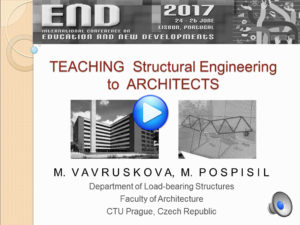 Title: TEACHING STRUCTURAL ENGINEERING TO ARCHITECTS
Title: TEACHING STRUCTURAL ENGINEERING TO ARCHITECTS
Structural Mechanics vs. Structural Design mix within the curricula
Submission code: VP_086
Author: Marketa Vavruskova & Martin Pospisil
Abstract: Introduction: A long-term research analysing role of Structural Engineering (SE) in architectural curricula is currently taking place at the Faculty of Architecture, Czech Technical University in Prague. We are comparing its study programmes to ones of selected leading English (12) and German (15) speaking European universities together with looking into innovative methods of teaching.
Previous findings: SE appears to be an important part of architectural curricula, its share ranges as follows:
Bachelor
10-15% (English)
15-25% (German) and 35% for top rated universities.
Majority of master architectural courses have up to 5% of SE in their curricula.
For combined courses of Architectural Engineering, the share of SE can be further boosted up to 45%.
Student-centered instructional and constructivist approach seems to be more beneficial for architectural students compared to traditional teacher-centered instructional and behaviourist approach.
Objectives: The main objective of this paper is to examine approach of particular universities from our sample as far as Structural Mechanics vs. Structural Design mix within their architectural curricula is concerned.
Methods: Applied research: comparison, observation and analysis.
Results: Structural Mechanics (SM) courses represent theoretical introduction into basic laws and principles of mechanics, on which further builds up Structural Design (SD). The ratio of SM vs. SD subjects in the curricula ranges considerably within selected universities (see detailed analysis).
Conclusions: Our research has not found “universal” approach towards the problematics. Some universities from our selection put an emphasis on students’ understanding of mechanics’ principles, some prefer “learning by doing” approach (see the full text for more detail).
All students practice gained skills within their individual projects in later stages of their studies.
Keywords: Structural engineering, architectural curricula, education.
File Extension: Windows Media Audio/Video file (.wmv)
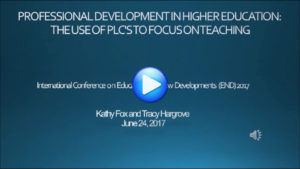 Title: PROFESSIONAL DEVELOPMENT IN HIGHER EDUCATION: THE USE OF PLC’S TO FOCUS ON TEACHING
Title: PROFESSIONAL DEVELOPMENT IN HIGHER EDUCATION: THE USE OF PLC’S TO FOCUS ON TEACHING
Submission code: VP_126
Author: Kathy Fox & Tracy Hargrove
Abstract: Remaining relevant to pre-service teachers is a concern for faculty in higher education. This challenge may be exacerbated when classroom practices include changing technology and a generation of
pre-service teachers who live within an electronic social network that includes their classrooms and professional networks. A departmental professional learning community (PLC), defined as an organized focus on the “process of intensive reflection upon instructional practices, benchmarks, and outcomes to ensure success and enable teachers to continually learn from one another via shared visioning and planning, as well as critical examination of what does and doesn’t work (DuFour, 2004), was the chosen method to investigate teaching practices. Typically considered a strategy for classroom teachers in grades K-12, a PLC was developed at a college of education in order to support faculty in teacher education as they focused on updating their teaching to include current practices in K-12 classrooms. Department administration, operating from the unique insider perspective of seasoned faculty members now serving as department and assistant department chair, distributed surveys, held focus groups and sponsored collaborative events both on and off campus in order to encourage an atmosphere of collegiality mediated by a focus on teacher excellence. The resulting home-grown PLC offered faculty engagement across the department, an increase in student learning within courses, and a source of continual renewal among the PLC stakeholders. Evidence showed ongoing expansion of leadership roles as an outcome of the practice.
This research contributes to the field of teacher education in multiple ways. It is our belief that this initiative has fostered development among our departmental colleagues and our students. It offers faculty a model for professional development that fosters collaboration and socially responsive support among peers. Additionally, it provides a platform for teacher educators to model effective instructional techniques for pre-service teachers and then to serve as a departmental expert and leader in training colleagues. Students have been able to observe a PLC at work much like the PLCs in which they will participate during their future career as teachers. Moreover, the use of cutting-edge technology and innovative instructional practices may impact the work that our pre-service teachers do in their own classrooms, thereby promoting greater opportunities for academic success for their own students.
Keywords: Teacher education, professional development, higher education, collaborative communities, innovation.
File Extension: MP4 Video (.mp4)
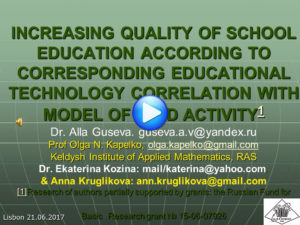 Title: INCREASING QUALITY OF SCHOOL EDUCATION ACCORDING TO CORRESPONDING EDUCATIONAL TECHNOLOGY CORRELATION WITH MODEL OF MIND ACTIVITY
Title: INCREASING QUALITY OF SCHOOL EDUCATION ACCORDING TO CORRESPONDING EDUCATIONAL TECHNOLOGY CORRELATION WITH MODEL OF MIND ACTIVITY
Submission code: VP_259
Author: Olga Nikolaevna Kapelko, Alla Vasilievna Guseva, Ekaterina Kozina, & Anna Kruglikova
Abstract: New requirements and societal expectations placed on graduates for the XXI century, demand increasing quality of education at every step and level of learning. The conception of ‘lifelong leaning’ demands understanding of quality ways of learning for receiving significant results. Our experience of connecting educational process using mind model / also referred to as an information perception by a student, is based on the concept of triadic code. The results of the research work that used triadic code show increase attainment of students and generally better results of studying in all levels of school education. Overall, the quality of the product could be assessed in the following way – is the means by which to reveal the correlation between the end product to a standard product (relative quality) or the ideal product – the absolute quality. We suppose that in order to reach the absolute quality in education we must take into account the differences between our students when designing the curriculum. In our methodology we use the theory of a triadic code as base for educational technologies. In philosophy the idea of a triadic code goes back to ancient times. Plato used this idea for description of a society.
On the one hand, it can be argued that education has two main functions: to educate and to train. If they don’t go together in childhood, the education of a student can deteriorate and it will be difficult to correct it. To clarify each of the issues, when developing a curriculum first, we have to teach ‘WHAT IS IT?’
On the other hand we represented education as a process by means of which a teacher teaches ‘What is it?’, ‘How to use it? and ‘Why should I know it?’ These are also the major questions we ask ourselves during our lifetime and which are raised by our thinking.
Keywords: Quality of education, image of mind activity, triadic code, model of information thinking, personality model.
File Extension: Windows Media Audio/Video file (.wmv)
 Title: CREATING ONLINE COMMUNITY THROUGH E-LEARNING FACULTY MENTORSHIP PROGRAMS
Title: CREATING ONLINE COMMUNITY THROUGH E-LEARNING FACULTY MENTORSHIP PROGRAMS
Submission code: VP_334
Author: Aubrey Statti & Kelly Torres
Abstract: Research indicates that faculty mentorship provides the needed academic guidance and personal connection that many students desire and require in order to be successful in higher education. Researchers suggest that these mentorship relationships between faculty and students should be based on trust, integrity, and opportunity. The inclusion of faculty mentoring has been described as creating a zone of proximal development in which students are able to receive support based on their current academic skills and needs. The role of faculty mentors goes beyond them simply being an advisor. These individuals provide students a wealth of resources, support, wisdom, guidance, and encouragement. Ultimately, faculty mentors generally provide students with both academic and career guidance as well as psychosocial support. Through these mentorship relationships, students are able to gain self-confidence, develop appropriate goals, and continue to successfully progress through their doctoral programs. Students also receive support that helps them develop and enhance their graduate and professional identities, which can have a significant impact on student persistence. Thus, mentor relationships have been shown to positively impact student retention, student connections and feelings towards their education, dissertation completion and research productivity, and students’ potential career advancement. Researchers have also found that students who are more actively involved in their colleges/universities are more likely to graduate.
The research literature specifically documents the positive impacts of faculty and student mentor relationships with first year undergraduate students, first generation students in college, students seeking degrees in the medical professions, minority and female students, and doctoral-level students.
While traditional mentoring has generally taken place face-to-face, the growth of online education has created the need for mentoring to take place from a distance, yet to still produce the same supportive results. Particularly, faculty may need to carefully consider how to most effectively develop online mentorship programs that emphasize students’ experiences to ensure academic growth and empowerment. The inclusion of these types of programs have become significantly more important in online learning contexts due to the growth and continual popularity of e-learning programs.
This presentation will focus on means of creating and building a constructive faculty and student mentor relationship through the uses of technology and e-learning as a method of creating engagement in students’ learning, research interests, and future career success. Additionally, this presentation will provide insight into the development of an online faculty mentorship program and strategies for creating a supportive and engaged community of learners.
Keywords: Faculty Mentor Relationships; Doctoral Faculty Mentorship; E-learning Mentor Relationships.
File Extension: MP4 Video (.mp4)
 Title: CLASSROOM-BASED VALUES EDUCATION IN VIETNAM: IMPLEMENTATION AND ISSUES
Title: CLASSROOM-BASED VALUES EDUCATION IN VIETNAM: IMPLEMENTATION AND ISSUES
Submission code: VP_388
Author: Quynh Thi Nhu Nguyen
Abstract: Values education from the whole school approach is examined at three levels including the school level, the classroom level and the community level. At classroom level, values education is enacted and interpreted from general curriculum to specific values-focused lessons and activities for each class community. Values education is also implicit through the teacher-student relationships and teacher modelling. This paper explores how values education is implemented at the classroom level in two upper secondary schools in Vietnam. The study follows a qualitative research design with semi-structured interviews of sixteen teachers and observation of their teaching. The findings focus on the most important values should be taught, implicit and explicit teaching methods and evaluation of values education at the classroom level. It reveals tensions in teaching values and initiatives which teachers used to promote values. The study concludes that it is necessary to select the value – honesty to teach in upper secondary schools in Vietnam. Furthermore, new educational strategies should be developed to help teachers regarding values education pedagogy and evaluation.
Keywords: Values education, teacher-student relationships, teacher modelling, curriculum, upper secondary school.
File Extension: MP4 Video (.mp4)
 Title: EDUCATIONAL PROFESSIONALISM AND TRAINING OF SECONDARY EDUCATION TEACHERS
Title: EDUCATIONAL PROFESSIONALISM AND TRAINING OF SECONDARY EDUCATION TEACHERS
Submission code: VP_429
Author: Manuel Delgado-García, Francisco Javier García Prieto, Pablo Maraver López, & Inmaculada Iglesias Villarán
Abstract: The training of secondary school teachers in Spain has suffered a substantial change since 2006 when the Spanish Organic Law on Education promoted the creation of the Master’s Degree in Secondary Education and Vocational Education and Teaching of Languages (MAES) as a necessary requirement for teaching at this stage of education. As a consequence, the configuration of current curricula is at the center of the criticism of the educational community and hence, this work tries to deepen an essential factor linked to the training of future teachers as is the configuration, as well as the development of their professionalism and teaching identity.
This work is part of a study carried out with 198 students from MAES of the University of Seville (Spain) and is structured based on a mixed methodological design. Through a brief semi-structured survey, composed of 5 multiple-choice items and 1 open-ended item, the students’ opinions are more deeply related to factors that, linked to initial training, contribute to the development and achievement of a process of constructing the significant teaching identity, while also exploring the interest in teaching and the relevance of the teaching vocation.
The results obtained place us at a starting point in which 89.9% is clearly positioned in the line of having a clear interest in teaching in the secondary stage. Since then, a large majority of students (70.1%) maintain that although vocation is an essential quality for the exercise of the teaching profession, this is not achieved in pedagogical training courses. On the other hand, the factors that contribute to the significant configuration of this teaching identity, are included in three main focuses of action: teachers (need for a motivated and experienced teacher), curricular planning (period of more extensive professional practices, subjects Associated with didactics or psychology) and didactic methodology
(use of active methodologies, work with real cases, promotion of communicative skills and competences, motivation, conflict resolution in the classroom, etc.).
In short, the students focus on three key areas to be revitalized by the institutions, to avoid that the current initial training of secondary school teachers is committed to a course of initiation to secondary education empty of meaning.
Keywords: Teacher Education Programs, Secondary School Teachers, Vocational Education Teachers, Professional Identity, Professional Development.
File Extension: Windows Media Audio/Video file (.wmv)
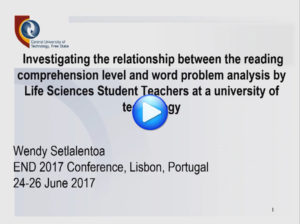 Title: INVESTIGATING THE RELATIONSHIP BETWEEN THE READING COMPREHENSION LEVEL AND WORD PROBLEM ANALYSIS BY LIFE SCIENCES STUDENT TEACHERS AT A UNIVERSITY OF TECHNOLOGY
Title: INVESTIGATING THE RELATIONSHIP BETWEEN THE READING COMPREHENSION LEVEL AND WORD PROBLEM ANALYSIS BY LIFE SCIENCES STUDENT TEACHERS AT A UNIVERSITY OF TECHNOLOGY
Submission code: VP_512
Author: Wendy Setlalentoa
Abstract: This study aimed to investigate the relationship between reading comprehension level and word problem analysis skill of Life Sciences Student Teachers at a university of technology through a correlational design. Convenience sampling was used. Data were collected from a convenient sample of fifty (50) life sciences student teachers using a questionnaire comprising fifteen (15) questions comprising Life Sciences Genetics word problems and the Scholastic Reading Inventory (SRI). The results revealed a Cronbach’s alpha value of 0.87 which is interpreted as excellent. Furthermore, the research results revealed that 36% of the respondents are below basic and 14% are advanced readers. Findings also revealed that 50% of the respondents have a word problem analysis skill that is equal to their level of study. A Pearson-r formula giving a coefficient of 0.376 was utilized to correlate the two variables. Based on the results, there is a low positive correlation between reading comprehension and word problem analysis. A regression analysis conducted to determine a simple relationship between the two variables showed that there was an average increase of 0.53 points per 100 point-lexile increase from a standard average score of 7.45 out of 15 items; which implies that reading comprehension minimally affects the word problem analysis of the students.
Keywords: Word problem, reading comprehension.
File Extension: MP4 Video (.mp4)
Projects and Trends
 Title: VIDEOS, EDUCATIONAL ROBOTICS AND PUPPETS: AN EXPERIMENTAL INTEGRATION OF LANGUAGES
Title: VIDEOS, EDUCATIONAL ROBOTICS AND PUPPETS: AN EXPERIMENTAL INTEGRATION OF LANGUAGES
Submission code: VP_144
Author: Lorenzo Denicolai, Renato Grimaldi, & Silvia Palmieri
Abstract: This paper aims to present the results of an experimental activity in Media Education and Educational Robotics, based on the integration of the audiovisual language (video), the Robotics language (LOGO) and the ancient theatrical language of marionettes (puppets of the Italian Dynasty of the Lupi Family). This case study is part of a wide research about the role of the multimedia language and innovation in Education, Pedagogy and Anthropology of Media.
Our research group works following two experimental directions: first, we consider Media Education as a method to teach the grammar and syntax of the multimedia language, to help students not only to read with media but also to write (they can participate in the collective creation of materials for the increase of the cognitive surplus). Of course, we want to educate them to communicate and produce meanings. They should acquire technological skills and digital competences, and overcome some learning difficulties. Secondly, we use educational robotics to increase some basic notions about the visual and spatial skills (above all, in primary schools) and to help students acquire some processes of reasoning, such as the logic of problem solving and creative problem solving. At the same time, we want to help students develop a comparative awareness between the ancient and traditional language of the theatrical puppets and the modern video language and the robot language.
Starting from these aspects and from previous technological and media laboratories (with primary and secondary school students), we experiment with an innovative methodological approach to realize storytelling videos with robots and puppets. In this activity, students create some short films, starting from their imagination and working on the storytelling process; robots (Bee-bot and Pro-bot) and marionettes are the protagonists of these videos. Students must ideate the tale (which is about a comparison between the traditional age and the postmodern-technological age), build the scenography, programme the robots and realize the video, thinking about how robots can move and interact with others and with space, according to the script. In this way, students must consider the skills to realize a communicative video and, at the same time, the code requirements to move a robot as well as how it is possible to create a meaningful product with these technologies. In this paper, we describe this experiment, its educative aims and its results (obtained during the 3rd edition of the Summer Junior University, 2016, Turin, Italy). R. Grimaldi and S. Palmieri wrote 1 and 4 paragraphs; L. Denicolai wrote 2 and 3.
Keywords: Audio-visual Language, Educational Robotics, Theatrical language, Innovation, Media Education.
File Extension: MP4 Video (.mp4)
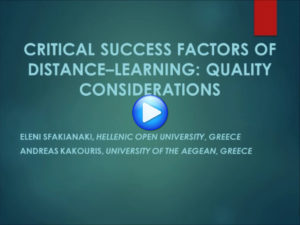 Title: CRITICAL SUCCESS FACTORS OF DISTANCE–LEARNING: QUALITY CONSIDERATIONS
Title: CRITICAL SUCCESS FACTORS OF DISTANCE–LEARNING: QUALITY CONSIDERATIONS
Submission code: VP_193
Author: Eleni Sfakianaki & Andreas Kakouris
Abstract: The objective of this paper is to map the published literature with respect to the factors that are likely to influence distance learning implementation. A systematic literature review (SLR) was conducted to identify relevant publications using as a source for the review the following three databases: Emerald, Elsevier (Science Direct), and Wiley. The literature was assessed based on analysis of characteristics relating to publications and authors. Of the 230 publications identified, 81 were included for systematic review. One of the main findings of this research is that the distance learning appears to be in the state of an emerging field, in the sense that it is intended to emphasize specific issues only, not the “big picture”. Also a number of meaningful factors were extracted from the publication list of those three databases, which will be the basis of future empirical research in order to develop a more complete picture of the relative impact of each to influencing DL implementation. By only using the three electronic databases the study may not have allowed a complete coverage of all empirical articles in the field of CSFs in DL implementation. Also the fact that the literature review was restricted to specific search terms this could also be a limitation of this study. Nevertheless, it is believed that the findings provide a valuable understanding of the current situation in this research field.
Keywords: Assessment, Literature review, critical-success-factors, distance- learning, quality.
File Extension: MP4 Video (.mp4)
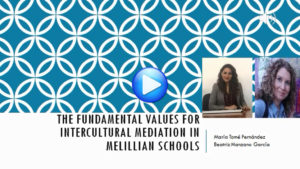 Title: THE FUNDAMENTAL VALUES FOR INTERCULTURAL MEDIATION IN MELILLIAN SCHOOLS
Title: THE FUNDAMENTAL VALUES FOR INTERCULTURAL MEDIATION IN MELILLIAN SCHOOLS
Submission code: VP_233
Author: María Tomé-Fernández & Beatriz Manzano-García
Abstract: Melilla is a Spanish city situated in the north of Africa. This city reflects the cultural diversity currently enjoyed by most European cities it receives a large number of immigrants. So much so, that in the last decades Melilla has been enriched by the different cultures and people from the south of Africa, Pakistan or Syria. This fact has complemented the current cultural diversity which already exists. This cultural mix manifests the need to educate young people in common values in the classroom to guarantee the peaceful coexistence and the cultural tolerance of students. For this reason we focus on the diagnosis of intercultural values in the Melilla school classrooms (N = 150). These values are evaluated through the intercultural values questionnaire (Tomé, 2012) and analysed through the latest version of the statistical software (SPSS). This questionnaire collects data about three types of intercultural values: primary, secondary and tertiary. The purpose is to detect the goals in which the role of teachers in Melilla (as cultural mediators) should be focused. This research is financed by the Institute of the Cultures of Melilla through the competitive program of scholarships about this topic.
Keywords: Intercultural Values, Intercultural mediation, Intercultural Education, Melilla, Institute of the Cultures.
File Extension: Windows Media Audio/Video file (.wmv)
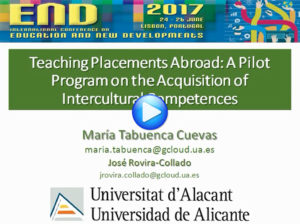 Title: TEACHING PLACEMENTS ABROAD: A PILOT PROGRAM ON THE ACQUISITION OF INTERCULTURAL COMPETENCES
Title: TEACHING PLACEMENTS ABROAD: A PILOT PROGRAM ON THE ACQUISITION OF INTERCULTURAL COMPETENCES
Submission code: VP_235
Author: Maria Tabuenca-Cuevas & José Rovira-Collado
Abstract: This study describes a pilot programme within a European project on transferable skills acquired on work placements abroad. During three different placement periods from 2012-15, groups of up to twelve Primary Education students from the University of Alicante participated each year during three months on a pilot programme to measure the acquisition of intercultural competences. The study was divided into various phases: initial testing, pre-departure training, reflection diaries and post testing. Firstly, the students were asked to take the Intercultural Development Inventory (IDI) test prior to their departure. Based on the results, pre-departure intercultural training was designed and delivered at the home institution. In the next step, during the twelve weeks of the teaching training placement at different Primary schools in England, Italy and France, the students wrote an on-line reflective diary that had a dozen guided questions. Each week they had to reflect and write about a different question. Lastly, upon their return, these students took the IDI test a second time to measure competency gain. The results of this pilot programme show the benefits of pre-departure training and reflective diaries to aid students in the acquisition of intercultural competences on work placements at schools abroad.
Keywords: Teaching placements, abroad, intercultural competence, diaries, reflection.
File Extension: Windows Media Audio/Video file (.wmv)
 Title: EDUCATIONAL BLOGS AND NARRATIVES TO DEVELOP A PROFESSIONAL NOTICING: EXPERIENCES OF PRE-SERVICE SPANISH LANGUAGE TEACHERS
Title: EDUCATIONAL BLOGS AND NARRATIVES TO DEVELOP A PROFESSIONAL NOTICING: EXPERIENCES OF PRE-SERVICE SPANISH LANGUAGE TEACHERS
Submission code: VP_236
Author: José Rovira Collado & María Tabuenca Cuevas
Abstract: narratives and blogs in their development of professional noticing regarding their own teacher education. These tools were chosen as they can aid students to identify and reflect on the learning contents and teaching objectives in the classroom. In this study, one of the specific goals for Primary Education and Master’s students is to identify how learning takes place in the area of Spanish Language and Literature. Firstly, the narratives of a group of Primary Education pre-service teachers are analyzed during their school placements. The narratives allow us to see how students perceive the direct experience of giving a real class of Spanish Language and Literature during their placements. Students compile and describe teaching situations where the expected subject contents are presented and taught in the Primary classroom. The narratives explore the differences between the theory and the reality of teaching in the Primary classroom. Secondly, the Master’s students´ blogs during their placements are analyzed. These blogs offer multiple perspectives of learning situations in the Spanish Language and Literature classroom and collectively foster teaching competences from different perspectives as multiple contributors discuss and describe classroom experiences. In both cases, the need to foster a professional vision on teaching is fostered through the use of narratives and blogs. The analysis of these show how pre-service teachers identify the development of the competence in linguistic communication, reading comprehension and literary education in the subject of Spanish Language and Literature in Primary and Secondary school students.
Keywords: Spanish Language and Literature, blogs, narratives, professional noticing.
File Extension: Windows Media Audio/Video file (.wmv)
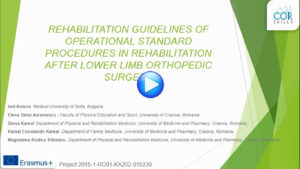 Title: REHABILITATION GUIDELINES OF OPERATIONAL STANDARD PROCEDURES IN REHABILITATION AFTER LOWER LIMB
Title: REHABILITATION GUIDELINES OF OPERATIONAL STANDARD PROCEDURES IN REHABILITATION AFTER LOWER LIMB
ORTHOPEDIC SURGERY
Submission code: VP_251
Author: Ivet Koleva, Elena Taina Avramescu, Diana Kamal, Kamal Constantin Kamal, & Magdalena Rodica Trăistaru
Abstract: Rehab Guidelines is an online information resource providing up-to-date treatment guidelines to medical doctors – residents and specialists in physical and rehabilitation medicine and to rehabilitation professionals. We decided to develop the Rehab Guidelines of operational standard procedures in rehabilitation after lower limb orthopedic surgery, as one of the major outputs of COR-skills project, funded by ERASMUS+ and addresses to Vocational Education and training (VET) on higher education level. Designed to help therapists provide post-surgical rehabilitation based on best practices and evidence-based research, this comprehensive reference presents effective guidelines for rehabilitation postsurgical interventions. Our Strategic Partnership involves a diverse range of partners in order to benefit from their diverse experience, profiles and specific expertise to produce relevant and high quality project results. The consortium includes hospitals, and higher education institutions well known in the field, with consistent experience and strong networks with their target groups from 3 countries (Romania, Bulgaria and Turkey) with high qualified specialists in orthopedics & traumatology and in physical & rehabilitation medicine with a longstanding reputation for providing student- focused programs for health education. This guideline introduces a brief picture of 12 selected standard rehabilitation operational procedures after lower limb orthopedic surgery for hip, knee and ankle, aiming to develop basic skills for medical specialists in rehabilitation (theoretical and practical skills for assessment, decision, and rehabilitation treatment in different pathologies). For each procedure, there are correspondent videos, capturing real practice maneuvers presented in the guide that will create support for autonomous learning practical skills for the trainees. Each presented procedure includes: the rationale for the procedure, role of diagnosis, preliminary recommendations, rehabilitation timing and methodology, early postoperative exercises and prophylaxis of complications, intermediate exercise program, advanced exercises and activities, complex PRM program and communication with patients. The easy to follow guidelines enable practitioners to look up pathology and quickly see the recommended rehabilitation strategy. Phases of treatment are defined to clearly show goals, precautions, treatment strategies and criteria for rehabilitation. This summary of recommendations is not intended to stand alone. Treatments and procedures applicable to the individual patient rely on mutual communication between patient, physician and other healthcare practitioners. We aim that this partnership between education and employment will stimulate the flow exchange of knowledge between higher education and hospitals / medical clinics and will lead to the development of high quality VET with a strong work-based learning component.
Keywords: Vocational education, rehabilitation, guidelines, procedures, lower limb.
File Extension: Windows Media Audio/Video file (.wmv)
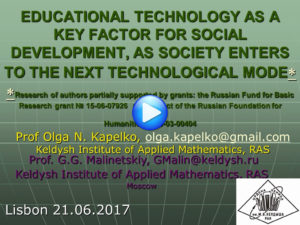 Title: EDUCATIONAL TECHNOLOGY AS A KEY FACTOR FOR SOCIAL DEVELOPMENT, AS SOCIETY ENTERS TO THE NEXT
Title: EDUCATIONAL TECHNOLOGY AS A KEY FACTOR FOR SOCIAL DEVELOPMENT, AS SOCIETY ENTERS TO THE NEXT
TECHNOLOGICAL MODE
Submission code: VP_255
Author: Olga Nikolaevna Kapelko, Georgiy Gennedievich Malinetskiy, & Lev Alexandrovich Samoilov
Abstract: We can see a global process of changing technological mode that demands specialists for the new branches of Technologies. To make education more effective for preparing future specialists, we need understand future needs that connect with next Technological Mode. To illustrate these tendencies, firstly we will present and discuss how the waves of World economical development described by Russian economist Nicolay Dmitrievich Kondratyev are connecting with requirement of changing educational approaches for the new technological modes. Every technological mode is linked to a specific type of educational system that is prevalent in a given society, as we also argue.
Secondly, we will show correlation between the changing mode and the need to prepare personnel to be equipped to use the new technologies such as bio- and nano-technologies, multimedia-programs and IT technologies used in humanitarian purposes in forecasting and foresight, based on mathematical modeling. We argue that these processes have become the base for development of social system.
Keywords: Strategic purposes of education, economical waves, economical cycles, interdisciplinarity, innovative education.
File Extension: Windows Media Audio/Video file (.wmv)
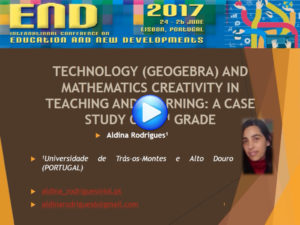 Title: TECHNOLOGY (GEOGEBRA) AND MATHEMATICS CREATIVITY IN TEACHING AND LEARNING: A CASE STUDY OF 9TH GRADE
Title: TECHNOLOGY (GEOGEBRA) AND MATHEMATICS CREATIVITY IN TEACHING AND LEARNING: A CASE STUDY OF 9TH GRADE
Submission code: VP_261
Author: Aldina Rodrigues
Abstract: Recent investigations have shown the advantages of using the software Geogebra in the mathematics’ classroom and in mathematics teaching. More studies have shown that mathematics students’ creativity can be promoted through new teaching methodologies and that means implementing tasks and the use of technology. In general, the students they have difficulties in the learning of mathematics and lack of motivation. The contexts using technology to facilitate the learning of mathematical concepts and promoting to mathematics creativity. The attempt to overcome this problem situation was the motivation for this investigation. This study addressed whether a teaching experience performed with dynamic geometry software Geogebra, to analyze the participants’ conceptions about the use of the software, their contributions and mathematical creativity and to evaluate the mathematical creativity of the participants in the resolution of tasks involving the quadratic function. The study sample was two classes of total 32 participants (12-16 years old) the 9th grade of a public school in the northern region of Portugal, in the school year 2014/2015. The methodology used was qualitative, following a case study and the instrument for data collection was the questionnaire survey and mathematics productions tasks, implemented in mathematics’ class. In the data processing it was included the analysis of the responses of students in the questionnaire survey and in tasks, using content analysis by formulating categories of analysis. Analyzing the results, it can be concluded that participants associating mathematics creativity concept the “Innovation”, they liked to use Geogebra in class because allowed to learn in innovative way, facilitating the learning of concepts. In evaluated the mathematics creativity, the teaching experience showed that the fluency and flexibility were the dimensions of the most representative mathematical creativity varying in student’s responses in different items of the task. This investigation contributed to show wick can the promotion of participants’ mathematical creativity with the use of technology and the motivation for the discipline.
Keywords: Mathematics Creativity, Teaching and Learning, Geogebra, 3rd Cycle of Basic Education.
File Extension: MP4 Video (.mp4)
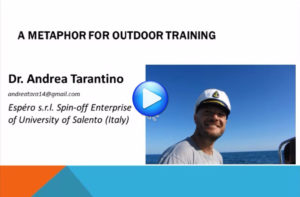 Title: A METAPHOR FOR OUTDOOR TRAINING
Title: A METAPHOR FOR OUTDOOR TRAINING
Submission code: VP_289
Author: Andrea Tarantino
Abstract: On the basis of experiential learning, outdoor training and metaphorical learning theories, this paper demonstrates theoretically and methodologically how fishery can become an effective experiential learning environment. “Being in the same boat”, in this paper, is not just a metaphor but the learning setting. In this learning setting the group, under the trainer’s careful monitoring/facilitation, has the opportunity to experience itself in a highly stimulating and participatory environment, gaining relational and communicative skills.
Keywords: Experiential Learning, Outdoor Training, Metaphorical Learning, Adult education.
File Extension: MP4 Video (.mp4)
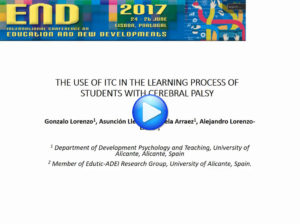 Title: THE USE OF ITC IN THE LEARNING PROCESS OF STUDENTS WITH CEREBRAL PALSY
Title: THE USE OF ITC IN THE LEARNING PROCESS OF STUDENTS WITH CEREBRAL PALSY
Submission code: VP_292
Author: Gonzalo Lorenzo, Asunción Lledó, Graciela Arraez, & Alejandro Lorenzo-Lledó
Abstract: We live in a society where technology is one of the most important elements. Anyone is fully integrated if they don’t know how the use this instrument. It offers a gret variety of possibilities to the students present in our classroom. Perhaps one of the least studied disabilities is cerebral palsy. There are a lot of computer applications that have not found their use in specific cases. Therefore the aim of our research was to analyse and reflect about the contribution of ICTs in the motor, cognitive and soci-affective structure of this students. Moreover it was analyse the improves of this methods in front of classical methodologies. In order to obtain this goal we made an Intervention proposal using ICB (Interactive Communication Board) that was applied to an eleven year-old student inside her learning environment. Using direct observation and serving us a registration desk we analyse the skills put in place by the students in the different methodologies ( Using TIC and classical material). This Intervention was produced during three months. Each seassion lasted one hour twice a week. The results indicated a higher degree of motivation, development of motor skills, independence and self-esteem in the interactive activities. It’s indicate he importance of the use of ICT in the learning process of students with special education needs.
Keywords: ITC, Cerebral Palsy, Learning process, special need educations, disability.
File Extension: MP4 Video (.mp4)
 Title: THE USE OF THE INTERACTIVE DIGITAL WHITEBOARD IN STUDENTS WITH ATTENTION DEFICIT DISORDER AND HYPERACTIVITY: INTERVENTION PROPOSAL
Title: THE USE OF THE INTERACTIVE DIGITAL WHITEBOARD IN STUDENTS WITH ATTENTION DEFICIT DISORDER AND HYPERACTIVITY: INTERVENTION PROPOSAL
Submission code: VP_298
Author: Gonzalo Lorenzo, Graciela Arráez, Asunción Lledó, & Alejandro Lorenzo-Lledó
Abstract: We live in a society where different types of technologies exist. Everybody has their own mobile phone, tablet or other technological elements. This types of instrument are beginning to be used in our classes.
In fact if we visit some of them, we will be able to see how children use it from very young. One of the elements that has evolved most is the blackboard. Now they are interactive and digital and allow the students to created new learning environments. Hence the diversity of our class, the main objective of our research is the development of an educational initiative focused on the interactive digital whiteboard in students with Attention Deficit Disorder and Hyperactivity. Moreover we want to improve attention and the impulsiveness of this students. We applied our activity to one student who is studying 3rd Primary at ordinary public school. This student was nine years-old and thus the proposal was adapted to this level. The results have shown that we can enhance the learning of students in attention deficit, using new technologies such as interactive digital whiteboards, which nowadays can be found in almost all schools and all classrooms.
Keywords: ADDH, ITC, Intervention, hyperactivity, disorders.
File Extension: MP4 Video (.mp4)
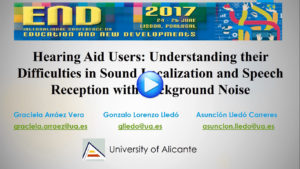 Title: HEARING AID USERS: UNDERSTANDING THEIR DIFFICULTIES IN SOUND LOCALIZATION AND SPEECH RECEPTION WITH BACKGROUND NOISE
Title: HEARING AID USERS: UNDERSTANDING THEIR DIFFICULTIES IN SOUND LOCALIZATION AND SPEECH RECEPTION WITH BACKGROUND NOISE
Submission code: VP_307
Author: Graciela Arráez Vera, Gonzalo Lorenzo Lledó, & Asunción Lledó Carreres
Abstract: Individuals with functional diversity associated with hearing loss show significant difficulties to locate the origin of the sounds and to understand the speech reception in a noisy classroom. The aim of this study has been to analyse the difficulties that interfere in different environments and situations to develop the skills to locate the source of the sound and speech reception in users of hearing aids. The method used to achieve this goal revolved around the creation of a discussion group formed by 6 children‒ 3 of them users of binaural hearing aids and the other 3 with binaural cochlear implants‒ whose ages ranged between 6 and 17 years old.
The information-collecting process was oriented to offer an individual and a collective description of the factors that interfered with the ability to adequately locate the origin of sounds and speech reception in the immediate environment. Our findings revealed that the main difficulty is understanding the speech in environments in which there is background noise. The paper concludes with a number of orientations and proposals which are likely to bring an improvement in the acquisition of skills in their ability to determine the location of a sound and to recognize speech in a noisy background
Keywords: Hearing aids, hearing loss, discussion group, sound localization, speech reception in noise.
File Extension: MP4 Video (.mp4)
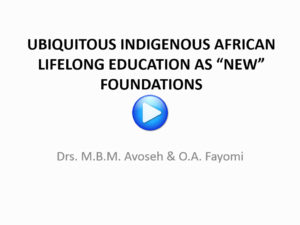 Title: UBIQUITOUS INDIGENOUS AFRICAN LIFELONG EDUCATION AS “NEW” FOUNDATIONS FOR SUSTAINABLE HUMAN DEVELOPMENT
Title: UBIQUITOUS INDIGENOUS AFRICAN LIFELONG EDUCATION AS “NEW” FOUNDATIONS FOR SUSTAINABLE HUMAN DEVELOPMENT
Submission code: VP_313
Author: Mejai B.M. Avoseh & Olugbenga Abimbola Fayomi
Abstract: The call for alternative approaches and to education in the age of globalization has come from many fronts including from outside education. The call has especially been accentuated by the fact that most researchers and authors have affirmed growing inequity across the globe and the widening of the
poor-rich gap. Most have queried the role of education in addressing the slanted “development” in spite of the resources committed to education. Part of the conclusion from most analysist is the fact that education has not hitherto truly been serving the cause of the “common good” of humanity. UNESCO has, in a 2015 book entitle Rethinking education, argued for an almost root and branch re-setting of education. Their argument builds on the premise that education is still the most viable source of building sustainable human and social development. However, the most compelling argument in the face of the irresistible diversity of the global community is the need for education to look beyond the status quo and often Eurocentric frameworks of education.
This paper presents indigenous African lifelong education as one of the many new approaches that complement and enhance the push towards a universal and humanistic approach to education for sustainable human and social developments. It combines theorizing from literature with the authors’ empirical and existential connections to indigenous African education to offer an alternative approach. It summarizes the comprehensive, critical, eclectic, humanist, womb-to-tomb (lifelong), and ubiquitous nature of indigenous epistemology. The paper concludes by presenting African indigenous lifelong learning as one of the “new” and necessary foundations for education that serves the common good of humanity.
Keywords: African, indigenous, lifelong-learning, teaching.
File Extension: Windows Media Audio/Video file (.wmv)
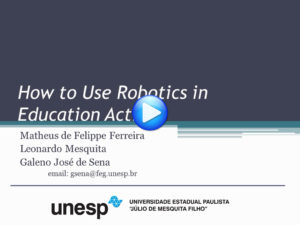 Title: HOW TO USE ROBOTICS IN EDUCATION ACTIONS
Title: HOW TO USE ROBOTICS IN EDUCATION ACTIONS
Submission code: VP_502
Author: Matheus de Felippe Ferreira, Leonardo Mesquita, & Galeno José de Sena
Abstract: The extensive contact with various electronic devices and the massive implementation of the so-called Internet of Things (IoT) make children, from a very early age, interact with such devices more and more frequently, influencing everything from their habits and likings to their predisposition to absorb new concepts and ideas. A growing movement on the global stage is the integration of technological learning with the standard school subjects, in order to make the students put into practice the knowledge obtained in the classes, fostering the logical reasoning and stimulating the interest. This does not only in the courses of the Mathematic’s area, but also in the courses of the Human Sciences’, especially in those courses in which they find themselves discouraged in the face of more complex situations.
The use of educational robotics to stimulate student learning in the public school system is a reality in several developed countries of the world. However, this does not apply to Brazil, as this type of methodology is almost non-existent in the country’s public schools. With educational robotics, it is possible to develop interactive, practical and playful learning instruments aimed at children and teens in order to, mainly, aid the theoretical knowledge of Mathematics and Physics areas, along valuable competencies like teamwork and critical thinking.
This work proposes the development of didactic material and application methodology of a mini-course of Educational Robotics for teachers and students of high school, being able to be adapted for other professionals and enthusiasts who wish to work with this theme. The mini-course covers the topics and concepts of electronics and programming based in Arduino Platform, aimed at presenting the main resources of this platform, both hardware and software, available to propose and develop educational projects. As a concrete development of our group, working at the Center InovEE – Inovation Center for Energy Efficiency, located at the Sao Paulo State University (UNESP), we will present and discuss the results of the application of a short duration course for high school students in the Vale do Paraíba region, Brazil, performed at the UNESP- Campus of Guaratinguetá.
Keywords: Educational Robotics, Arduino, Robotics Platform.
File Extension: Windows Media Audio/Video file (.wmv)
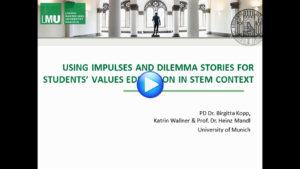 Title: USING IMPULSES AND DILEMMA STORIES FOR STUDENTS’ VALUES EDUCATION IN STEM CONTEXT
Title: USING IMPULSES AND DILEMMA STORIES FOR STUDENTS’ VALUES EDUCATION IN STEM CONTEXT
Submission code: VP_177
Author: Birgitta Kopp, Katrin Wallner, & Heinz Mandl
Abstract: Values education is a main objective of education in general and of schools in particular. In a global world, in which multi-culturalism is part of our daily lives, values get more and more important. Specifically dilemmas are used in diverse approaches for values education in school, e.g. the Values and Knowledge Education approach. But such approaches implement dilemmas mainly in language education or social subjects, not in scientific subjects. Thus, we didactically enriched experiments with impulses and dilemma stories in order to sensitize students for values like environmental consciousness or self-activity. We evaluated its realization with two experiments in a third and a fourth grade of an elementary school using qualitative observation and interview data with teachers. Results indicate an effective integration of impulses and dilemma stories in the experimental material in order to foster the sensitization for values. For both classes, a combination of impulses and dilemma stories at the end of the lesson was most effective. Furthermore, students were able to take the protagonists’ perspective in the dilemma story and discussed diverse opinions. As the students’ activity is of great importance to stimulate reflection on values, this didactical realization was helpful. Overall, this study gives first indications that impulses and dilemma stories are adequate didactical methods to stimulate the sensitization for values in STEM context for students in elementary schools.
Keywords: Impulses, Dilemma Stories, Values Education, STEM Context, Elementary Schools.
File Extension: Windows Media Audio/Video file (.wmv)
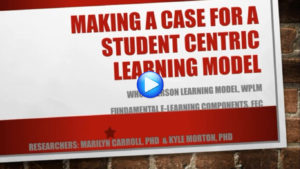 Title: MAKING A CASE FOR A STUDENT CENTRIC LEARNING MODEL
Title: MAKING A CASE FOR A STUDENT CENTRIC LEARNING MODEL
Submission code: VP_354
Author: Kyle F. Morton & Marilyn Carroll
Abstract: In this paper we propose the Whole Person Learning Model which is comprised of seven components, which include (1) assessing and customizing a student’s learning and thinking styles; (2) incorporation of the Whole Brain Teaching Model; (3) individual student coaching; (4) effective use of technology in a curriculum; (5) learning motivation; (6) Psychological Capital; and (7) establishing a standard for assessing or adapting a teacher’s pedagogical style. This model gives students the ability to take more ownership of their own education and encouraging them to become more motivated in this new educational age.
Keywords: Whole person, student centric, education, online, whole brain.
File Extension: MP4 Video (.mp4)
Teaching and Learning
 Title: LEARNING CLASSICAL MUSIC THROUGH IMPROVISATION: (A NEW APPROACH?) INSTRUCTION FOR USE
Title: LEARNING CLASSICAL MUSIC THROUGH IMPROVISATION: (A NEW APPROACH?) INSTRUCTION FOR USE
Submission code: VP_079
Author: Alberto Firrincieli
Abstract: The author takes the cue from some historical considerations about modern teaching & learning process in classical music. While in the past most renowned musicians have considered improvisation and composition as a complementary aspect of performance, today for almost all music students the practice of improvisation seems to be not necessary at all, and often only a very basic knowledge of harmony and theory is requested to complete their studies. Presently it is very rare to find a classic music student able to improvise a short prelude or compose a little music piece with confidence. Investigating possible reasons of this shift, we may notice that by one side since the last post-war a remarkable significance has been given to technical approach, on the other side music teaching has been reduced essentially on the reproduction of the symbols of the music score. In order to re-establish the lost balance among improvisation, composition and performance, the author proposes a different approach to classic music, starting from improvisation and consequently understanding of musical structures. In his almost ten-year experience of teaching in Asian countries, he developed the idea that the proper way to approach classical music should not be based on a mere reading of the notes without awareness of the musical structure, as well as fulfilment of a given composition should not be based on reiterated mechanical repetitions of the same passage. The author elaborated a simple as well as efficient method to introduce students to improvisation: starting from the invention a melodic and/or rhythmic fragment, the student is led step by step to the creation and completion of the musical piece. During class students have chance to discover, experiment, test diverse possibilities and get familiarity with essential elements of the music. The study of improvisation let students look at the music under a different perspective: it represents a valuable support for the real understanding of the music score, an aid to penetrate composer’s mental process and an unique way to learn how to create music.
Keywords: Improvisation, piano pedagogy, learning process, practicing methodologies.
File Extension: Movie Clip (.mpg)
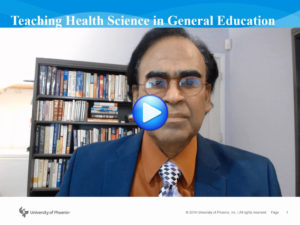 Title: TEACHING HEALTH SCIENCE IN GENERAL EDUCATION
Title: TEACHING HEALTH SCIENCE IN GENERAL EDUCATION
Submission code: VP_402
Author: Mohammed Miah
Abstract: For all students, learning health science is as important as learning mathematics or writing. In general education, the emphasis is on reading, writing, arithmetic, critical thinking, and communication; this article claims that teaching health science to all students is equally important. Students come to school with a hope that school is the place where they can learn to change their future regarding their social value and financial outlooks. The author claimed that academic achievement could only provide little benefit to a student who suffers from chronic debilitating health symptoms. Even a healthy person needs to learn how to stay healthy because s/he may lose many influences in the academic and in real world if s/he becomes a victim of a wearying disease. After the completion of the degree, to move forward in life, a good health remains as essential as a good academic achievement if not more. After a degree is complete, the diploma and the record of academic achievement will stay with the student for the rest of his or her life; however, good health will always require their attention and remains a prerequisite for success.
By looking at the social aspect of it, one can hardly overemphasize the fact that health care cost is increasing significantly in the US and in many other western nations. The solution to such escalation lies in the old proverb, “Prevention is the best cure.” But, the focus of mainstream research is on maintaining the symptoms of diseases—not on preventions.
This article brings to focus that almost all serious health afflictions are rooted in habits. Their symptoms always start inside the body, but the internal mechanism of the body continuously repairs the small damages caused by habits. Unfortunately, as people age, body’s capacity to make necessary repairs diminishes often requiring medical intervention, but medicine can suppress the symptoms—it cannot cure a body, which has lost its ability to self-repair.
The author claims that achieving and maintaining good health requires lifelong learning. It involves listening to the body. Through the immune system, a body continuously communicates to its resident, but then again, some contacts come through only when it is too late—it is just a message that a severe damage has occurred such as high blood pressure, diabetes, and stroke. This article discussed some new developments in health sciences that all students need to know to protect themselves from these deadly diseases and argues that, for this purpose, colleges and universities can be venues for all students.
Keywords: Arterial Calcification, Chronic Disease, Health Science, Lifelong Learning, Menaquinone.
File Extension: Windows Media Audio/Video file (.wmv)
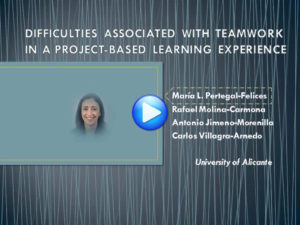 Title: DIFFICULTIES ASSOCIATED WITH TEAMWORK IN A PROJECT-BASED LEARNING EXPERIENCE
Title: DIFFICULTIES ASSOCIATED WITH TEAMWORK IN A PROJECT-BASED LEARNING EXPERIENCE
Submission code: VP_417
Author: María L. Pertegal-Felices, Rafael Molina-Carmona, Antonio Jimeno-Morenilla, & Carlos Villagra-Arnedo
Abstract: With the aim of reproducing in the University the labor world to which the graduates will incorporate in the future, the University of Alicante decided to develop the last year of the Degree in Multimedia Engineering through a project-based learning methodology in work teams. Students develop the learning activities within a university framework that simulates a work environment. The objective of this research is to know how the teams work and the difficulties that the students find in the development of the projects. To carry out the projects, the students form teams with an indeterminate number of members, since they are given the freedom to group according to their preferences. The sample of this research was made up of 59 students enrolled in the last year of Multimedia Engineering. To know the organization of the groups, the students were surveyed using an anonymous questionnaire on the degree of personal satisfaction related to issues about the functioning of the teams. The questionnaires were administered through the Moodle platform at the end of the academic year. Students responded to questions through a Likert scale (1 strongly disagree-5 strongly agree). From the answers provided by the students, it has been verified that most students evaluated the functioning of their groups in a positive way. However, it is noteworthy that in many cases the students in a group know each other in advance because of the freedom to make up the teams. This aspect influences the good functioning of the teams and it is important to emphasize that, in an actual work environment, people joining work teams seldom has the possibility of choosing who they want to work with. Despite the fact that the students’ choices in the formation of the work teams were free, it should be noted that there were some negative opinions: 12% of the students negatively perceived a member of the group by barely letting others intervene, 14% were dissatisfied with the assumed role, 19% reported lack of motivation, 20% considered that the group size was inadequate, 24% perceived ineffectiveness, 27% detected a lack of participation by all members, 22% reported the lack of a leader and up to 50% considered that they had a bad organization in the group, with the consequent wasted time.
Keywords: Project-based learning, teamwork, generic skills, difficulties.
File Extension: Windows Media Audio/Video file (.wmv)
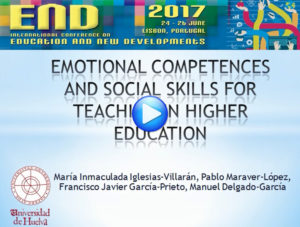 Title: EMOTIONAL COMPETENCES AND SOCIAL SKILLS FOR TEACHING IN HIGHER EDUCATION
Title: EMOTIONAL COMPETENCES AND SOCIAL SKILLS FOR TEACHING IN HIGHER EDUCATION
Submission code: VP_430
Author: María Inmaculada Iglesias-Villarán, Pablo Maraver-López, Francisco Javier García-Prieto, & Manuel Delgado-García
Abstract: Within the field of education, the influence of social and emotional aspects in the teaching-learning process is increasingly evident. The interactions that occur between professors and students are marked by the social and emotional skills they possess. In the case of the professors, they act as a socializing agent for the students, so their actions play a fundamental role in establishing optimal interaction conditions.
In this article we present a series of shared reflections by a team of higher education professors from the University of Huelva (Spain) in relation to the development and acquisition of the social and emotional skills necessary for an adequate teaching exercise, based on their experiences.
Specifically, this paper aims to analyze what should be the emotional competences and social skills that can enable a university professor to mediate and lead the teaching-learning processes that are established in Spanish universities classrooms in the present.
In this way, we have performed an analysis throughout the teaching exercise. The initial period is usually characterized by lack of experience, feelings of frustration and restlessness. As the professional trajectory progresses, the approach of different questions arises as well as the search for educational responses generating a series of guidelines that consolidate over time and which show the main social and emotional skills for teaching in higher education.
Based on the experience presented and the literature review carried out, it is evident the importance of emotional competences and social skills for the teaching-learning process, in which university professors participate, as well as the need to develop training programs for teachers, providing them with the necessary emotional and social skills.
Keywords: Emotional Competences, Social Skills, Teaching, Higher Education.
File Extension: Windows Media Audio/Video file (.wmv)
Organizational Issues
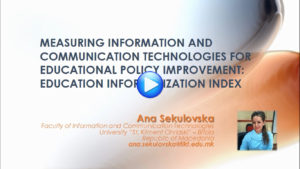 Title: MEASURING INFORMATION AND COMMUNICATION TECHNOLOGIES FOR EDUCATIONAL POLICY IMPROVEMENT: EDUCATION INFORMATIZATION INDEX
Title: MEASURING INFORMATION AND COMMUNICATION TECHNOLOGIES FOR EDUCATIONAL POLICY IMPROVEMENT: EDUCATION INFORMATIZATION INDEX
Submission code: VP_136
Author: Ana Sekulovska
Abstract: The extent by which a geographical area, an economy or a society is becoming information-based, i.e., increase in size of its information labor force, is referred to as informatization. How can we know what our position is in the process of global informatization? What development strategies should be taken? To reap the benefits of the rapidly changing information society, governments need to monitor and benchmark progress based on measurable indicators with a view to designing and reviewing national policies and strategies. On the other hand, the principles and government policy-making in the educational sphere, as well as the collection of laws and rules that govern the operation of education systems are educational policy. Seeing the informatization as a measure of the educational policy and starting from the available indicators in the World Economic Forum’s Global Information Technology Report (GITR), we follow the methodology for calculation of the Chinese National Informatization Index Quantity (NIQ) to propose an informatization level assessment framework and introduce a composite indicator – Education Informatization Index (EII). Although it is made up of only two main categories (Educational Policy Implementation subindex and Educational Policy Creation subindex) and a total of six individual indicators, it captures well all the socio-political flows in the educational sphere in the Republic of Macedonia in the past five-year period (2012-2016). The Education Informatization Index (EII) is calculated as a weighted sum, and weights of subindexes and indicators are assigned by applying the Rank-Order Centroid method. As the selection of indicators is often the result of a process of trade-offs and negotiations among stakeholders, national respondents and international experts (one group of countries may perceive certain indicators as very policy-relevant and unproblematic, while other countries may judge the same indicators as irrelevant or too complex), there still remain some open questions about the number of subindexes, the number of aggregation levels, the number of indicators, methods for weight assignment, feasibility for collecting reliable data, and international comparability. Having in mind that policymakers can review progress of the country over time in comparison with their nationally defined targets and other relevant reference countries, the presented methodology and the results can help them in making informed decisions or in demonstrating greater commitment to integrating ICT into the education system. The ICT utilization in education should be promoted effectively, in line with the policy aiming to create a learning system and schools suitable for the 21st century.
Keywords: Informatization, educational policy, composite indicators, Education Informatization Index.
File Extension: Windows Media Audio/Video file (.wmv)
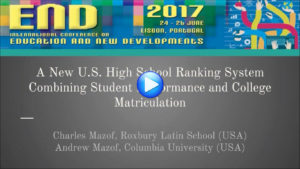 Title: A NEW U.S. HIGH SCHOOL RANKING SYSTEM WHICH COMBINES STUDENT PERFORMANCE AND COLLEGE MATRICULATION
Title: A NEW U.S. HIGH SCHOOL RANKING SYSTEM WHICH COMBINES STUDENT PERFORMANCE AND COLLEGE MATRICULATION
Submission code: VP_323
Author: Charles Mazof & Andrew Mazof
Abstract: This study aims to find a new indicator to compare or rank US secondary schools. Firstly, most currently existing rankings are only applicable to a specific type of institution, such as private or public. Collecting different school systems together in any existing ranking system does not give any meaningful guidance. Secondly, most current ranking systems, especially when college matriculation is considered, neglect the initial academic competitiveness in the student pool of each school. To resolve the above drawbacks, this study has reviewed and compared the most popular existing ranking systems for US high schools, and discussed their advantages and drawbacks. Using an analysis of the results, a novel ranking index and model is proposed. The new proposed ranking model finds a common base applicable to all types of secondary schools. Not only does it take consideration of college matriculation rate, but also includes a competitiveness or performance index in each school, thus the new method has eliminated the bias resulting from different school size, student performance, student selectiveness and sector (private or public). This converged method applies uniformly to all schools and becomes a practical indicator to help parents and student in making enrollment decisions. To conclude, a sample of selected competitive US high schools ranked and compared using different ranking methods is presented, which reflects the unique aspects of this new proposed method over others.
Keywords: Ranking, matriculations, US high School, national merit semifinalists.
File Extension: Windows Media Audio/Video file (.wmv)
